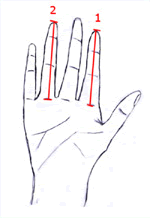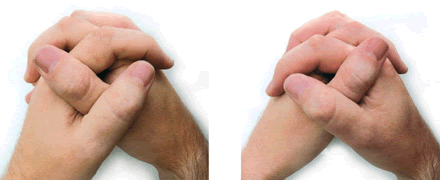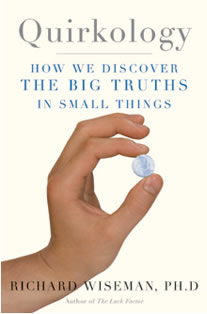Analyze Yourself
The Quirkology website contains several serious, and scientific, online experiments. However, we also thought it would be fun to have a few not-so-serious tests to help uncover the real quirky you. There are three tests below for your entertainment.
Test 1 - The Q-Test
What to do:
Using the first finger of your dominant hand, trace out the capital letter ‘Q’ on your forehead.
Analysis:
This fun test provides some insight into whether you are ‘self’ or ‘other’ centered. These two types of people have a very different way of seeing the world, and one type is no better or worse than the other.
There are two ways of completing this exercise. Some people draw the tail of the ‘Q’ on the right hand side of their forehead whilst others draw it on the left.

Self-centered people tend to draw the letter Q in a way in which it can be read by themselves. They tend to come across as being the 'same person' in different situations, and their behaviour is guided more by their own values than the needs of others. They pride themselves on being straight with people, and expect others to be honest with them. Because of this, they are not especially good at lying, but are better at detecting lies in others.
People who are other-centered tend to draw the letter Q in a way in which it can be seen by someone facing them. They tend to be concerned with how other people see them. They are happy being the center of attention, can easily adapt their behaviour to suit the situation in which they find themselves, and are skilled at influencing the way in which others see them. Because of this they are often good at lying, but not so good at detecting lies.
Test 2 - The Finger Test

What to do:
Hold out your right hand, place your fingers together, and compare the length of your index (first) finger and ring (third) finger (see picture opposite).
Analysis:
Everyone knows the sex of their body, but what about their brain?
The hormone ‘testosterone’ is linked with many traits traditionally seen as masculine, such as aggression, becoming frustrated when you don’t get your way, and, most important of all, social dominance. Those in highly competitive occupations, such as actors and footballers, tend to have much higher levels than those in more caring jobs, such as nurses and the clergy. Men have much greater levels of testosterone in their bodies and brains than women.
Scientists believe that the amount of testosterone we were exposed to in the womb affects the ratio of index finger length to ring finger length. The higher the testosterone exposure, the longer the ring finger. Most women's index and ring fingers are almost equal because they have been exposed to less testosterone. If women have longer ring fingers, then they have more masculine tendencies. In most men, the ring finger is longer because they have higher testosterone levels. If men have ring fingers equal in length to their index fingers, or shorter, they have less masculine tendencies because they have been exposed to slightly less testosterone.
Test 3 - The Thumb Test
What to do:
Interlock the fingers of your hands, and place one thumb on top of the other.
Analysis:
The brain works in two general modes. In one mode (often called ‘right-brained’), it is more intuitive, visual, and creative. In the other (often called ‘left-brained’), it is more logical, sequential, and language based. In many ways, it is like having an artist and accountant arguing in your head, and you keep flipping between the two.
All of us work in both modes, but everyone naturally tends towards one or the other.
People who place their right thumb on top of their left thumb tend to be left-brain dominant, and are thus more verbal and analytical. Those placing their left thumb on top of their right thumbs tend to be a right-brain dominant, and thus excel in visual, spatial and intuitive tasks.



